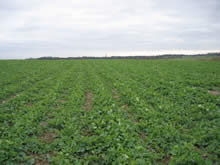Rape crop benefits from Till-Seeding in West Yorks
Better plant establishment and root structure have been achieved by West Yorkshire arable farmer Alan Copley after introducing the Till-Seeding technique on 100 acres of oil seed rape for the first time last year. 
Mr Copley grows 230 acres of oil seed rape at Hawthorne Farm, Purston, Pontefract, with the farm’s remaining acres down to winter wheat.
His interest in Till-Seeding – subsoiling and seeding straight into stubble with one pass - started this time last year when we saw an article in one of the farming magazines.
“I was very interested in what the farmer was doing – he had the same Simba Flatliner subsoiler as we have, he was on a similar wheat/rape rotation and he wanted a quick turn round after harvest.
“Obviously, he was also looking at establishments costs like I am, and that’s how we got started.”
An OPICO Air 8 Variocast seeder with a working width of up to 6.5 metres was mounted on the subsoiler using brackets made by a local engineer. The subsoiler was fitted with three legs but this season Mr Copley is considering adding another two.
“What we are finding is that the seed following the slit made by the leg is going down into moisture. The root system goes straight down – and you get a big healthy plant.”
Because the land varies from limestone to heavy clay, Mr. Copley uses three different seeding systems for the rape: discs plus Amazone Powerharrow disc drill combination; plough plus disc drill combination – and Till-Seeding.
“We use the plough on the easy working land and I can go straight in behind with the combination. The system works well and this year I am going to do the easy working land that way and use the subsoiler/Variocast on the heavy land – about 150 acres – after disking the stubble once.”
Subsoiling leaves the soil very loose which helps drainage, says Mr Copley - and, of course, with Till-Seeding he is cutting a pass out which is important.
“It’s a big help at harvest time because it means two of us can crack on and get it all done. Sometimes with the old system it took three of us, so we’ve cut down by a man and a tractor and speeded things up.”
Later this year, depending on the success of the rape crop, he is considering upgrading to a Variocast with variable seed rate.
“Our land can change within the field; heavy at one end, light at the other. Where it’s heavy I can put a couple of kg more and fine tune it that way.”
In addition to fitting another two legs to the subsoiler to create more tilth between the legs, he is also planning to convert a 3m mounted cultivator to go on the front of the tractor to see if this will work.
“Overall, we are very happy with the result from the first season. Major benefits were a better crop establishment and a better root structure – that’s been the most pleasing thing.”